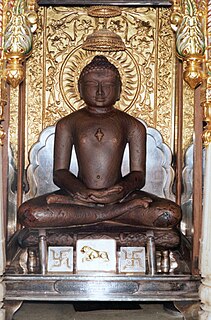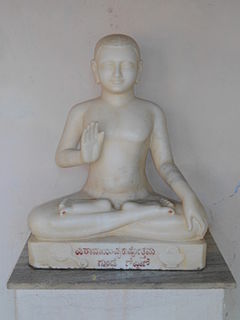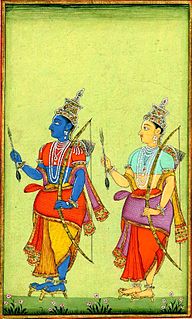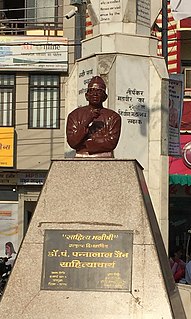
Mahavira also known as Vardhamana, was the 24th Tirthankara of Jainism. He was the spiritual successor of the 23rd Tirthankara Parshvanatha. Mahavira was born in the early part of the 6th century BCE into a royal Kshatriya Jain family in ancient India. His mother's name was Trishala and his father's name was Siddhartha. They were lay devotees of Parshvanatha. Mahavira abandoned all worldly possessions at the age of about 30 and left home in pursuit of spiritual awakening, becoming an ascetic. Mahavira practiced intense meditation and severe austerities for twelve and a half years, after which he attained Kevala Jnana (omniscience). He preached for 30 years and attained Moksha (liberation) in the 6th century BCE, although the year varies by sect.

Mahavir Janma Kalyanak is one of the most important religious festivals in Jainism. It celebrates the birth of Mahavir, the twenty-fourth and last Tirthankara of present Avasarpiṇī. On the Gregorian calendar, the holiday occurs either in March or April.

Acharya Virasena, also known as Veerasena, was a Digambara monk and belonged to the lineage of Acharya Kundakunda. He was an Indian mathematician and Jain philosopher and scholar. He was also known as a famous orator and an accomplished poet. His most reputed work is the Jain treatise Dhavala. The late Dr. Hiralal Jain places the completion of this treatise in 816 AD.

Ādi purāṇa is a 9th century Sanskrit poem composed by Jinasena, a Digambara monk. It deals with the life of Rishabhanatha, the first Tirthankara.

Amoghavarsha I was the greatest emperor of the Rashtrakuta dynasty, and one of the most notable rulers of Ancient India. His reign of 64 years is one of the longest precisely dated monarchical reigns on record. Many Kannada and Sanskrit scholars prospered during his rule, including the great Indian mathematician Mahaviracharya who wrote Ganita-sara-samgraha, Jinasena, Virasena, Shakatayan and Sri Vijaya.

Jinasena was a monk and scholar in the Digambara tradition of Jainism. He was patronized by the Rashtrakuta king Amoghavarsha I. He was the author of Adipurana and Mahapurana.

Trishala, also known as Videhadatta, Priyakarini, or Trishala Mata, was the mother of Mahavira, the 24th Tirthankara of Jainism, and wife of the Jain monarch, Siddhartha of Kundagrama, of present-day Bihar. She finds mention in the Jain texts.

Sambhavanatha was the third Jain tirthankara of the present age (Avasarpini). Sambhavanatha was born to King Jitari and Queen Susena at Sravasti. His birth date was the fourteenth day of the Margshrsha shukla month of the Indian calendar. Like all arihant, Sambhavanatha at the end of his life destroyed all associated karmas and attained moksha (liberation).

Mahapurana (महापुराण) or Trishashthilkshana Mahapurana is a major Jain text composed largely by Acharya Jinasena during the rule of Rashtrakuta ruler Amoghavarsha and completed by his pupil Gunabhadra in the 9th century CE. Mahapurana consists of two parts. The first part is Ādi purāṇa written by Acharya Jinasena. The second part is Uttarapurana which is the section composed by Gunabhadra.
Kashtha Sangha was a Digambar Jain monastic order once dominant in several regions of North and Western India. It is considered to be a branch of Mula Sangh itself. It is said to have originated from a town named Kashtha.
The Siribhoovalaya is a work of multi-lingual literature written by Kumudendu Muni, a Jain monk. The work is unique in that it employs not alphabets, but is composed entirely in Kannada numerals. The Saangathya metre of Kannada poetry is employed in the work. It uses numerals 1 through 64 and employs various patterns or bandhas in a frame of 729 (27×27) squares to represent alphabets in nearly 18 scripts and over 700 languages.
Kumudendu Muni was a Digambara monk who authored Siribhoovalaya, a unique multi-lingual literary work. Scholars are divided about when he lived and not much is known about him. It is believed that he was the spiritual teacher of King Amoghavarsha and a disciple of Virasena and Jinasena. He is said to have lived around thousand years ago. Pandit Yellappa Shashtri was the first one to decipher his creation, Siribhoovalaya. Karlamangalam Srikantaiah, the editor of the first edition, claims that the work may have been composed around 800 AD.

The Ṣaṭkhaṅḍāgama is the foremost and oldest Digambara Jain sacred text.

Malkheda, originally known as Manyakheta, and also known as Malkhed, is a town in Karnataka, India. It is located on the banks of Kadina River in Sedam Taluk of Kalaburagi district, around 40 km from Kalaburagi.

Digambara is one of the two major schools of Jainism, the other being Śvētāmbara (white-clad). The Sanskrit word Digambara means "sky-clad", referring to their traditional monastic practice of neither possessing nor wearing any clothes.

Rama (Rāma), the hero of Ramayana, is described in the Jain scriptures as one of sixty-three illustrious persons, known as Salakapurusa. Among these, there are nine sets of Balabhadra, Vasudeva and Prati-Vasudeva. Rama was the 8th Balabhadra with Lakshmana and Ravana being his Vasudeva and Prati-Vasudeva counterparts. He is described as a young prince who is deprived of his throne and turned into a pauper. While living in exile his wife Sita is kidnapped by Ravana, King of Lanka. Rama then rescues Sita with the help of his brother Lakshmana and King Sugriva. Ravana is killed by Lakshmana and they both go into hell. Rama becomes a Jain monk and his soul attains moksha. Sita becomes a Jain nun and is born into heaven as Indra.

Sahityacharya Dr. Pandit Pannalal Jain was a distinguished Jain scholar. Dr. Kasturchand Kasliwal has regarded him as among the 20 most distinguished of the Jain scholars of 20th century His teaching career spanned 70 years, from 1931 to 2001.

Uttarapurana is a Jain text composed by Acharya Gunabhadra in the 9th century CE. According to the Digambara Uttarapurana text, Mahavira was born in Kundpur in the Kingdom of the Videhas.















